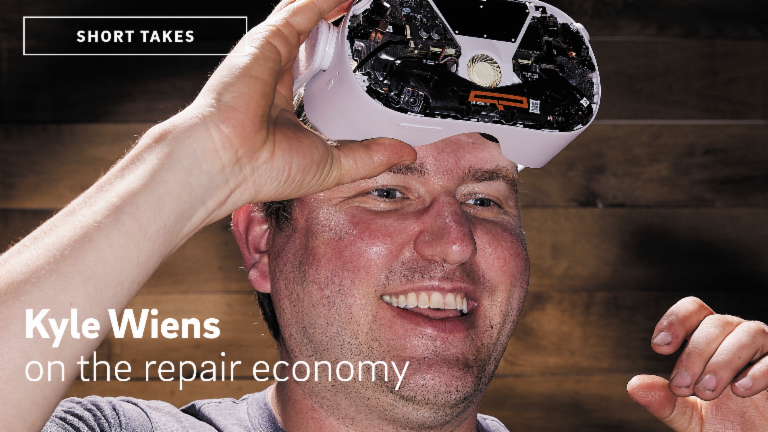Circular economy
![{[downloads[language].preview]}](https://www.rolandberger.com/publications/publication_image/roland_berger_ta37_cover_en_download_preview.png)
As the idea of sustainability becomes more mainstream, Think:Act shows how organizations can smoothly transition from a linear to a circular economy.


Repair has been a demand of sustainability experts and consumer advocates for decades, but manufacturers of a wide range of products have made it increasingly difficult to do just that. California-based iFixit is at the forefront of a global push to grant consumers the right to extend the lifespan of the things they own.
The fight against Big Tech's power has established an outpost in a small city halfway between San Francisco and Los Angeles. Here in San Luis Obispo, on California's scenic Highway 1, is the home of iFixit. Enter the front door of the company's headquarters and it's immediately clear that iFixit is on a mission.
A table in the lobby is covered with stacks of "Repair Manifesto" flyers and stickers calling on people to "Join the Repair Revolution" and "Fix the World," asserting that "if you can’t fix it, you don’t own it." The display extols the benefits of repairing devices, such as "Repair saves you money," "Repair saves the planet" or "Repair is freedom." The not-so-subtle message: Fixing stuff is not only an act of rebellion against manufacturers whose products are often designed to be short-lived and who have made it increasingly difficult to repair things. It's also an act of civic responsibility to the environment.
"Pick a company – they all have their flaws," says Kyle Wiens. "We need a system-wide move in the right direction and a rejection of designs that are short-lived." Wiens is iFixit's co-founder, chief executive and public face. The 38-year-old travels the world explaining to citizens, policymakers and advocates what his company does, the role repair plays in the circular economy and his overarching goal to enable people to repair the products they own.
"Repair happens at every point in the usage cycle and that keeps devices out of the trash."
iFixit and its 140 US employees – another 70 work in the European subsidiary in Stuttgart, Germany – are at the forefront of fighting for consumer- and eco-friendly devices and machines that are designed to be repairable and come with accessible repair information and spare parts. "It's our right to repair and I'd like to see a baseline of acceptable behavior set by policymakers and consumers preferring long-lasting products," says Wiens, a fast talker with a preference for checkered shirts and a haircut once described as one you might give yourself with a pair of dull scissors.
The company is an online repair community known not just for its vast library of product teardowns – disassembly photos and videos offering a peek inside gadgets – and free repair manuals showing how to repair everything from smartphones, computers and game consoles to cars, medical equipment and electric razors. It also sells tools and parts to consumers and professional repairers. At last count, there were over 80,000 manuals in twelve languages, two-thirds of them generated by a global community of tens of thousands of fixers, covering nearly 36,000 devices.
On the lower level of iFixit's building, a few employees are engaged in parts and tool testing and shipping orders. In the back is the warehouse with racks containing boxes with 10,000 different parts. "The downstairs is the operational money-side of our business that pays for our ability to do the advocacy and outreach work," says Sam Goldheart. She used to be the lead teardown engineer, traveling the globe to help iFixit be the first to tear down new gadgets like the Xbox One or the first iPhone Plus model. These days, Goldheart spends most of her time advocating and being iFixit's "historical voice," she explains as she climbs the stairs to the mostly deserted upper level. Pre-pandemic, it too was busy with teardown engineers creating videos and photos, developers, technical writers, translators and employees in advocacy work and journalism. Now most work from home.
iFixit also gives companies advice, Goldheart says. "We look at products and tell manufacturers that, for example, their battery could be easier to replace or a cable routing could be better so people are less likely to break it." They also offer toolkits and bundles of all the tools and parts one needs to repair a specific problem in a specific device. iFixit designs many of its own tools, since manufacturers don't make theirs available.
$21 million:
The revenue reported by iFixit in 2016, before it ceased public disclosure.
Wiens and co-founder Luke Soules launched iFixit in 2003 out of a dorm room when they were engineering students at California Polytechnic State University in San Luis Obispo. When Wiens graduated in 2005, a year before Soules, their business was generating $1 million in sales. iFixit doesn't disclose revenue anymore, but it topped $21 million in 2016 and growth has been up significantly since, says Soules. As COO, the 37-year-old is in charge of, as he says, the "less exciting part of keeping the business running," including the day-to-day logistics of getting replacement parts and tools to people all over the world. The pandemic with its supply chain issues has made Soules' tasks more complicated, also because travel restrictions ended his frequent trips to parts suppliers in Asia.
iFixit is considered a leader in the global "right to repair" movement that is fighting the growth of disposable culture and manufacturers' efforts to stop people from fixing their own stuff. Advocates and increasingly local and national governments believe that making repair accessible to everyone is the best shot the world has at reducing electronic and other waste, reducing the extraction of raw materials, migrating to a circular economy and making consumption more sustainable and less of a health and environmental hazard.
Device and machine makers rely on an assortment of economic, technological and legal techniques to curtail repair, according to Aaron Perzanowski, a professor of intellectual property law at Case Western Reserve University and a leading expert on fair repair laws. "Repair services are priced to encourage replacement. Marketing strategies emphasize incremental feature improvement to drive short upgrade cycles," he argues. "Product designs incorporate components that are difficult to replace or require expensive tools. Some devices are impossible to repair."
Companies restrict repairs for instance by intentionally complex product designs with specialized screws or excessive use of glue inside devices. "Quite a few years ago we saw this trend, started by Apple's iPhone, of gluing consumables like the battery into a device which limits the overall lifespan of a product to only two years," says Wiens. "Replacing the battery is not even a repair, it's like replacing car tires." John Deere has made it impossible for farmers to perform "unauthorized" repairs on their equipment, forcing tractor owners into using the company for repairs. There is also the common practice of "planned obsolescence," techniques by which manufacturers deliberately seek to shorten the lifespan of a product in order to increase its replacement rate.
"We need a system-wide move in the right direction and a rejection of designs that are short-lived."
Advocates stress that repair is central to the circular economy, much more so than recycling. "Repair happens at every point in the usage cycle and that keeps devices out of the trash," says Gay Gordon Byrne, executive director of the Repair Association, a right to repair advocacy group, via video call from her home in upstate New York. One of the big recycling myths is that factories are using recycled materials, she adds. They always buy new, it's a basic business principle, she explains: "If you're making a mass market product, and you're going to sell five million units, you cannot expect five million pieces of salvaged parts to come out of a drawer of some recycler. This is not a circle, but a line – from manufacturer to user and directly back to manufacturer."
The "right to repair” movement is starting to make some progress in pushing for changes, especially in rich countries, despite manufacturers working to squash proposals by legislators. France last year introduced a repairability index that requires manufacturers to rate how repairable their products are. The European Commission has promised a right to repair legislative proposal later this year as part of the European Green Deal. Twenty-seven US states are considering right to repair legislation or have already passed it. Last July, US President Joe Biden signed a sweeping executive order that includes an initiative to secure consumers' right to repair their own devices and targets manufacturers that block independent repair shops.
As manufacturers from Google to Tesla are also increasingly coming under pressure from consumers and shareholder activists, some are finally making concessions and starting to rethink how they build products. In October 2021, Microsoft announced that it will increase consumer options for device repair by the end of this year. In December iFixit announced that it had partnered up with the company to sell repair tools for its Surface devices — but only for certain service partners. Motorola, HTC and others also use iFixit as an official source for their distribution of parts and solutions. The biggest surprise came in November 2021 when the famously anti-repair Apple announced that individuals will be able to purchase parts and tools and obtain documentation necessary to repair certain devices from its website. The program started early this year in the US.
Though iFixit welcomes the news, skepticism remains as to whether this represents a change in Apple's philosophy or is just a move to comply with future regulations. "We'll have to wait and see what the details are. After two decades of seeing them stymie repair options at every turn, I'm somewhat skeptical, but I'm also optimistic. Their announcement is a big step," says Wiens. Despite the uphill battle that for iFixit started 19 years ago, Wiens envisions a "fully repairable future." "That's my goal," he insists. "We're working toward it – and we're a lot closer than we were even two years ago."
![{[downloads[language].preview]}](https://www.rolandberger.com/publications/publication_image/roland_berger_ta37_cover_en_download_preview.png)
As the idea of sustainability becomes more mainstream, Think:Act shows how organizations can smoothly transition from a linear to a circular economy.



_image_caption_none.png)
_image_caption_none.png)
